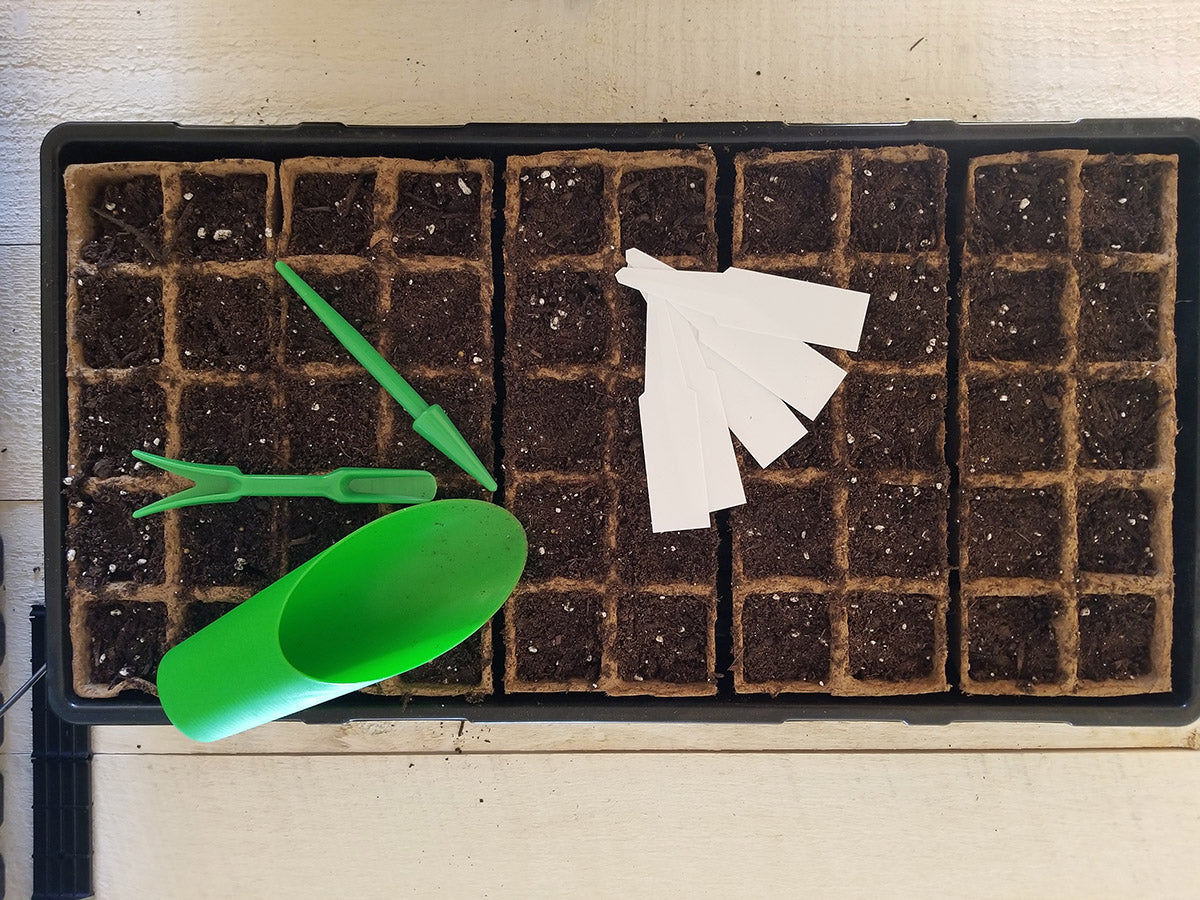Today we're going to talk about starting basil seeds indoors so you can transplant them outdoors once it warms up outside.
First, find a spot indoors that gets a lot of natural light and stays fairly warm (15-20 degrees Celsius/60-68 degrees Fahrenheit). If you don't have a spot like this, you may want to invest in a grow light and a seedling heat mat for faster growing and proper germination.
Step 1. Gather materials, soil, and seeds
Materials used in this planting:
- Daniel's Plants Biodegradable Trays
- Rigid 1020 trays without drain holes
- Nutritious potting soil with good drainage
- A small watering can
- Gardening tools (soil scoop, seed planting tools)
Step 2. Set up the seedling trays inside the plastic flat tray. This will save your gardening table from getting wet when you water. Five of our seedling trays fit perfectly into a standard 1020 flat.

Step 3. Fill the seedling trays with potting soil. You can just fill them flat with the top - once you water, the soil will sink down a little bit to give you a small recess for easier watering from the edge of the tray cells.

Step 4. Use a tool to make a small indent where you want to plant your seeds. In this case I had a very handy planting kit to help with this. You want to make sure to not plant your seeds too deep. For basil, we plant them approximately a quarter inch deep.


Step 5. Cover up your seeds and pat them down gently to make a good seal on top of the seeds. Again, make sure your seeds are not covered too deeply - we're looking for about a quarter inch coverage on top of the seeds.

Step 6. Water gently. This will settle down the soil slightly and make a good seal and make sure that the seeds start to absorb moisture and start their germination process. Make sure not to over-water or your soil and seeds will float away.

Step 7. Now we wait! Keep the top layer moist for the seeds to germinate. Consistency in watering is key - you don't want to over-soak but you do want to keep the top moist. A spray bottle can help with this too. Just giving soft sprays every day or two depending on your environment and humidity will work well.

Step 8. Once your seeds have sprouted give them fewer regular waterings, but deeper soakings. Especially with basil - basil doesn't like to be kept too wet. I always like to let them dry down so the top layer of the potting soil is dry and then give them deeper soakings every few days. Watering will greatly depend on the humidity in which you're growing and the heat levels.
Step 9. Transplant into your garden or planter! Once your basil plants have sprouted and matured a bit, you can simply tear the trays to make individual cells and plant them directly into the ground. The roots will grow right through the biodegradable pot and the basil will keep on growing without hesitation.
Troubleshooting: What to Do If White Mold Grows on the Pots
Occasionally, you might notice a bit of white mold forming on your biodegradable pots. This can happen when moisture lingers and airflow is limited. While this mold is generally harmless to your plants, it’s a good idea to take care of it to keep everything looking fresh and growing strong. Here’s how to tackle the issue:
-
Increase Airflow:
- Make sure your pots have some breathing room! If they’re grouped too closely, spread them out to allow for better air circulation.
- A small fan set to a gentle breeze can help move air around your seedlings, which not only keeps mold away but also encourages stronger stems.
-
Adjust Your Watering Routine:
- Mold loves damp conditions, so take care not to overwater. Let the top layer of soil dry out a little before watering again.
- If you’re using a humidity dome or cover, remove it or vent it regularly to prevent excess moisture from building up.
-
Clean Up Any Mold:
- If you spot mold on the pots, gently wipe it off with a soft cloth or scrape it away with a small tool. Be careful not to disturb your seedlings while doing this.
- For extra protection, lightly spray the area with a natural solution of one part white vinegar to three parts water.
-
Prevent Future Mold Growth:
- A quick spritz of diluted neem oil or another natural antifungal can help prevent the mold from coming back. Follow the instructions on the product for best results.
- Keep an eye on the environment where your pots are growing. Maintaining a consistent temperature (15-20°C/60-68°F) and avoiding overly humid conditions will make a big difference.
With these simple adjustments, you’ll keep your naked pots in tip-top shape and ensure your seedlings thrive. A little care goes a long way, and soon you’ll be ready to transplant your healthy basil plants into the garden!


